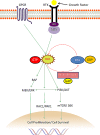The NF1 gene revisited - from bench to bedside
- PMID: 25026295
- PMCID: PMC4171599
- DOI: 10.18632/oncotarget.2194
The NF1 gene revisited - from bench to bedside
Abstract
Neurofibromatosis type 1 (NF1) is a relatively common tumour predisposition syndrome related to germline aberrations of NF1, a tumour suppressor gene. The gene product neurofibromin is a negative regulator of the Ras cellular proliferation pathway, and also exerts tumour suppression via other mechanisms. Recent next-generation sequencing projects have revealed somatic NF1 aberrations in various sporadic tumours. NF1 plays a critical role in a wide range of tumours. NF1 alterations appear to be associated with resistance to therapy and adverse outcomes in several tumour types. Identification of a patient's germline or somatic NF1 aberrations can be challenging, as NF1 is one of the largest human genes, with a myriad of possible mutations. Epigenetic factors may also also contribute to inadequate levels of neurofibromin in cancer cells. Clinical trials of NF1-based therapeutic approaches are currently limited. Preclinical studies on neurofibromin-deficient malignancies have mainly been on malignant peripheral nerve sheath tumour cell lines or xenografts derived from NF1 patients. However, the emerging recognition of the role of NF1 in sporadic cancers may lead to the development of NF1-based treatments for other tumour types. Improved understanding of the implications of NF1 aberrations is critical for the development of novel therapeutic strategies.
Figures



References
-
- Brosius S. A history of von Recklinghausen's NF1. J Hist Neurosci. 2010;19(4):333–348. - PubMed
-
- Rasmussen SA, Friedman JM. NF1 gene and neurofibromatosis 1. Am J Epidemiol. 2000;151(1):33–40. - PubMed
-
- Xu GF, O'Connell P, Viskochil D, Cawthon R, Robertson M, Culver M, Dunn D, Stevens J, Gesteland R, White R. The neurofibromatosis type 1 gene encodes a protein related to GAP. Cell. 1990;62(3):599–608. - PubMed
-
- Cawthon RM, Weiss R, Xu GF, Viskochil D, Culver M, Stevens J, Robertson M, Dunn D, Gesteland R, O'Connell P. A major segment of the neurofibromatosis type 1 gene: cDNA sequence, genomic structure, and point mutations. Cell. 1990;62(1):193–201. - PubMed
-
- Martin GA, Viskochil D, Bollag G, McCabe PC, Crosier WJ, Haubruck H, Conroy L, Clark R, O'Connell P, Cawthon RM. The GAP-related domain of the neurofibromatosis type 1 gene product interacts with ras p21. Cell. 1990;63(4):843–849. - PubMed
Publication types
MeSH terms
Substances
LinkOut - more resources
Full Text Sources
Other Literature Sources
Research Materials
Miscellaneous

